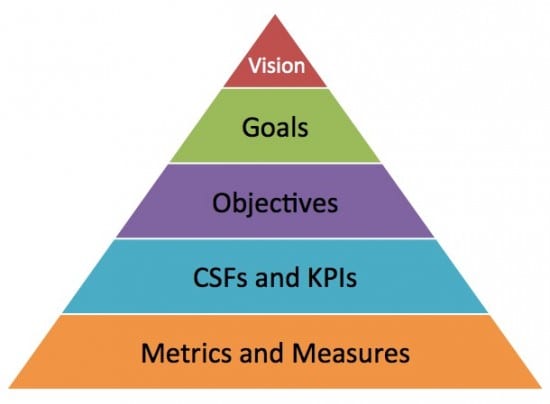A guide to setting high-level goals to keep your marketing on track
 The range of marketing channels available today and the rate at which they change drives to us to work longer, harder and more efficiently... it can often feel like you are ice skating uphill.
The range of marketing channels available today and the rate at which they change drives to us to work longer, harder and more efficiently... it can often feel like you are ice skating uphill.
The challenge can seem even harder if realistic goals aren't set to base your plans around. The lack of goals and just a constant, never-ending journey of 'change' can mean that we miss out on the rewards of achievement. My time spent as part of growing a marketing agency with smaller and larger multi billion dollar companies has taught me that both benefit businesses and staff benefit from moving to clearer goals.
Goals are different to objectives and KPIs
Even in my relatively short time in marketing (9 years), I have seen the rise of data, analytics, information and I for one value its power within organisations. That being said all this analysis, tools, insights are also one of the root causes to ineffective marketing and a lack of creativity.
I believe digital marketing teams have become too data orientated, they lack vision, creativity and confidence, goals are a way to solve this while keeping elements of measurement.
Goals are not commercial metrics or objectives, neither should they be about marketing performance indicators.
So, goals are a higher-level tool to help understand if you are on track or not and are important for different reasons to specific objectives. Without goals you don't have context for performance. In our Delivering Results from Digital Marketing Guide we give examples of broader vision and goals against more specific objectives.
Vision > Goals > Objectives > KPIs > Measures

To help remember the difference between these, just add your own prefixes:
Long-term Vision > Broad organisational goals > Specific SMART objectives > Performance driving KPIs

Recommended Guide: Delivering Results
A manager's guide to defining KPIs and dashboards to manage and improve digital marketing
Download our Delivering results from Digital Marketing Guide.
Examples of useful top-level goals
- Create the most remarkable customer service in our industry
- To be the most visible brand in our niche
- To make every one of our consumers want to talk about us
- To create the most remarkable brand experience known in our category
- Increase our site traffic while reducing overall media spend
Each of the above would allow you to rule out a lot of distractions, choices and channels. Imagine the power of that in your business. People can say 'No' without the fear. Let's face it, in 2013 it is easy to be busy doing lots of stuff, and work hard doing it, but without goals and focus its impact can be negligible, no matter your position in a company. Equally they can all be measured with 3-5 simple metrics.
Success and Goals
The definition of success: 'If you are working towards a pre-determined goal and know where you are going you are a success'. Earl Nightgale wrote this in the 'the strangest secret' in the 1950's where he argues that with goals you will be successful and I think it is true today as it was then. So are you a success?
Goals…
- Align teams - A team with a mission and a focus empowers them to work together rather than everyone pulling in different directions. It unites and creates a sense of purpose in an office environment.
- They create Leaders not Followers. Your colleges, staff, partners all want to grow and develop and all leaders / management should want to be worked out of a job. Goals help people move forwards, it gives them clarity and also a sense of achievement which aids confidence and encourages personal growth.
- Empower people to say no - Possibly the most important of all goals give people the ultimate focus. In a world where there is a million and one tactics, channels and ideas we 'could do'. Remove the any remote chance of procrastination and excuses for not performing / achieving.
- Give a sense of success - It is important to celebrate at the right times, and when is that?! When you achieve something of course. In a world where the bar is forever moving higher we need to ensure at the right time we celebrate to. It helps confidence, moral and well just that feel good factor!
- Operate at every level of businesses - Whether you are an CEO, Marketing Manager or SEM Executive goals have a role to play in your productivity, development and stress levels!
- Move us from day-to-day tactics to strategic growth -
5 Steps to setting and using Goals
The process below isn't new, Zig Ziglar and Seth Godin's book on goals explains a similar approach as does using SMART goals.
- Step One: Write down each goal and give target dates
First things first, write your goal down, give it a small description and set a date for completing it by. It can be 'within 12 months' as much as by 14th May 2014… Within digital marketing the 5S goals give a simple way to define a range of goals at a top level.
- Step Two: List the obstacles
List the core obstacles and risks you have to overcome to help you / your team / your business to achieve the goal. Is it time, resource, budget, skills, knowledge, process?
- Step Three: Understand the benefits and List Performance Indicators
Be clear on both the business benefits as well as the benefits to those in the business for achieving those goals. Being clear on the progress made is crucial to ensure you can set off on the right path. Considering the performance metrics you can monitor is also key at step 3. They should be things you can easily measure, make visible and are genuinely useful, i.e specific to the goal and your business.
If you are struggling to find which metrics are most important to you I recommend reading the Lean Analytics book, this will help you filter the right metrics.
- Step Four: Identify what you need and apply a process
Outline the top-level steps you need to take and who can help you on the journey. Be clear on what process you need and how often you should check against your key metrics Making goals visible, daily, weekly & monthly is crucial, a physical presence is often best if you are office based, like a graphical display or similar.
The 90 day action plans I describe give a practical way to plan activity against goals. Other things can be as simple as weekly round ups to view 3-5 KPIs and top-level deliverables to understand progress towards goals.
Zig Ziglar and Seth Godin call the process "the drip". The small daily tasks in pursuit of a goal that create the compounded impact we all seek. There are no right or wrong rules when it comes to getting the work done, use whatever methods and tools you are most comfortable with.
- Step Five: Reward or Walk Away
If you hit your goals what is your reward? What is the teams reward? What is your customers reward? Your partners / agencies rewards? Equally, what is your walk away point, at what point do you think, this goal is not right, it's too high, it didn't anticipate X and Y happening. When do you know to start the process again?.
This is a common concept in negotiations, you should never enter negotiations with understanding your parameters for walking away, the same goes for goals, not every goal is achievable and that is no bad thing as long you learn.
Are you aimlessly chasing a mass of activities without the structure of goals? Why not try this process and see the improvements you can gain?










